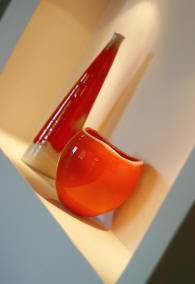How to Design a Shelf Display By Kathy Wilson
The Budget Decorator  Arranging a shelf display with interest and creativity can go a long way towards turning your hum drum accessories you already own into a dynamic display that delights your visitors, and saves you money! (No expensive Ming vase required!) Arranging a shelf display with interest and creativity can go a long way towards turning your hum drum accessories you already own into a dynamic display that delights your visitors, and saves you money! (No expensive Ming vase required!)
First thing you need to remember is that you are not just trying to fill shelf space, you are trying to share something about yourself or your family. Make it special! Choose items you love, or have meaning for you, and then combine them in ways that bring out their best. When arranging a shelf or cabinet top space with accessories, one has to keep in mind that the most important thing to avoid here is boredom! This has a lot less to do with the objects you choose than how you choose to display them. Start with your main, most important object, and place it slightly off center. If its small, feel free to prop it up on books or decorative boxes to give it height and importance. Now think in terms of a triangle, with the top of your main object being the point, and work down from there.
Make sure that the items you are using fit into the scale of the shelving space… you want to steer clear of using a huge ceiling high arrangement of flowers on a tiny end table or shelf, or a tiny seashell from vacation all alone on a huge armoire shelf. Most people tend to use things that are too small for their surroundings. If you have small accessories you would like to display, but need to give them more oomph in the arrangement, try grouping them on a plate or a fabric covered box. You can also give them height by perching them atop stacked books or baskets. Once you've chosen your objects for the space following the design principles above, now it's time to layer and soften. After placing your main focal object, work to the outer edges in layers…Add a taller background layer, a middle sized medium height layer, and your tiniest objects in the front. Keep the eye moving up and down as it purveys the arrangement from left to right for interest. Add some fabric or twisted ribbon to soften the edges of the shelf or table, to bring in color, and to highlight certain objects. To keep an arrangement from putting the neighbors down for their afternoon nap, remember to keep a balance of harmony (things that feel like they go together, like similar colors or styles) and contrast (things that spice things up by being different…smooth against texture, round against straight line, et…) You want a bit of both in your arrangement. If your arrangement feels bland, add some contrast in color or texture. Seems too busy? Take some contrast out and add some harmony…group all like colors or textures together, use smooth textured objects, and keep the colors in the same family. Above all, keep trying new combinations of items until you find an arrangement that works for you. Use things in unusual ways. Tuck flowers or a live plant into an arrangement that seems too static. Even professional designers will occasionally be surprised by trying things in a new way! And remember, if your arrangement still looks cluttered and lost, chances are you are trying to display too much. Develop a prop box or closet where you can keep some of your treasures, and switch them our a couple of times a year for a fresh new look without spending a dime! Kathy Wilson is an author, columnist, and editor of The Budget Decorator, Decorating Your Small Space, and Decorating Cottage Style. For thousands of free budget decorating ideas, visit her at http://www.TheBudgetDecorator.com. Be sure to sign up for her free newsletter while you're there! |